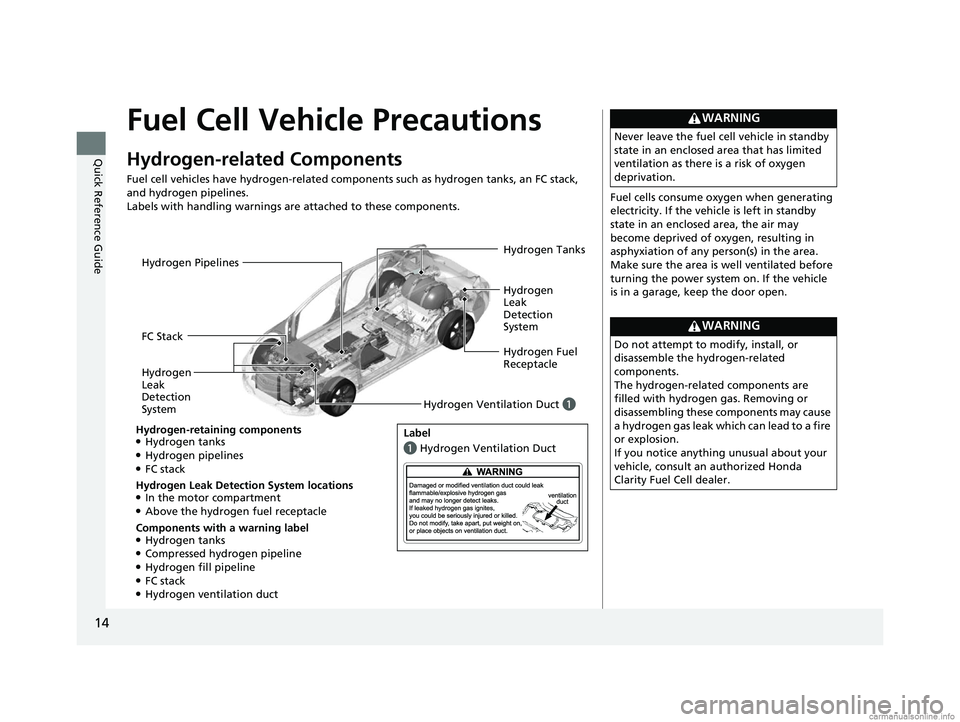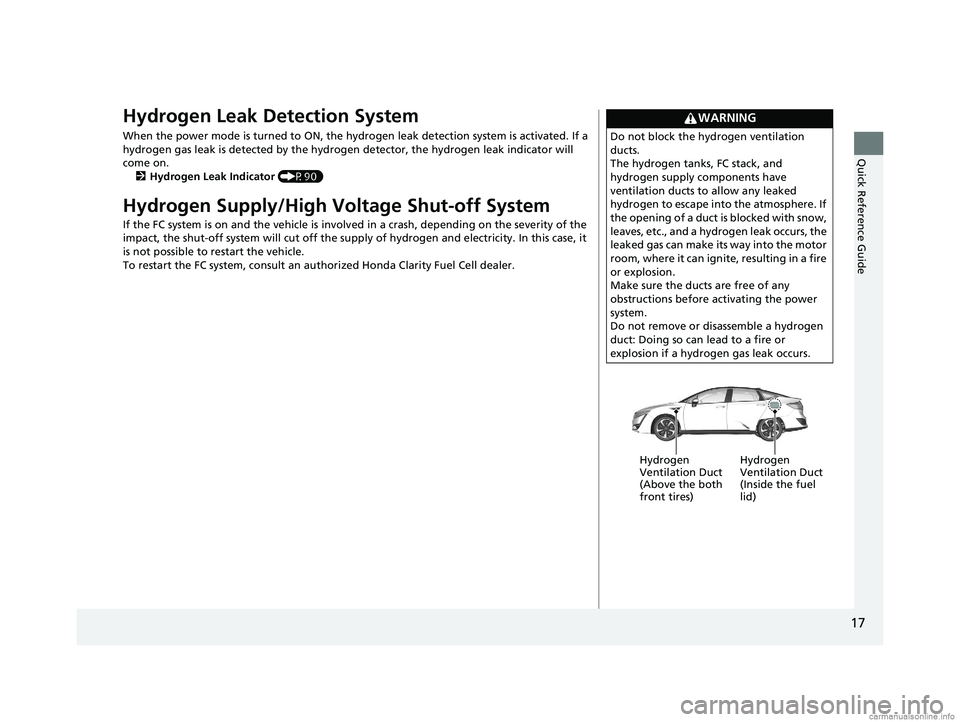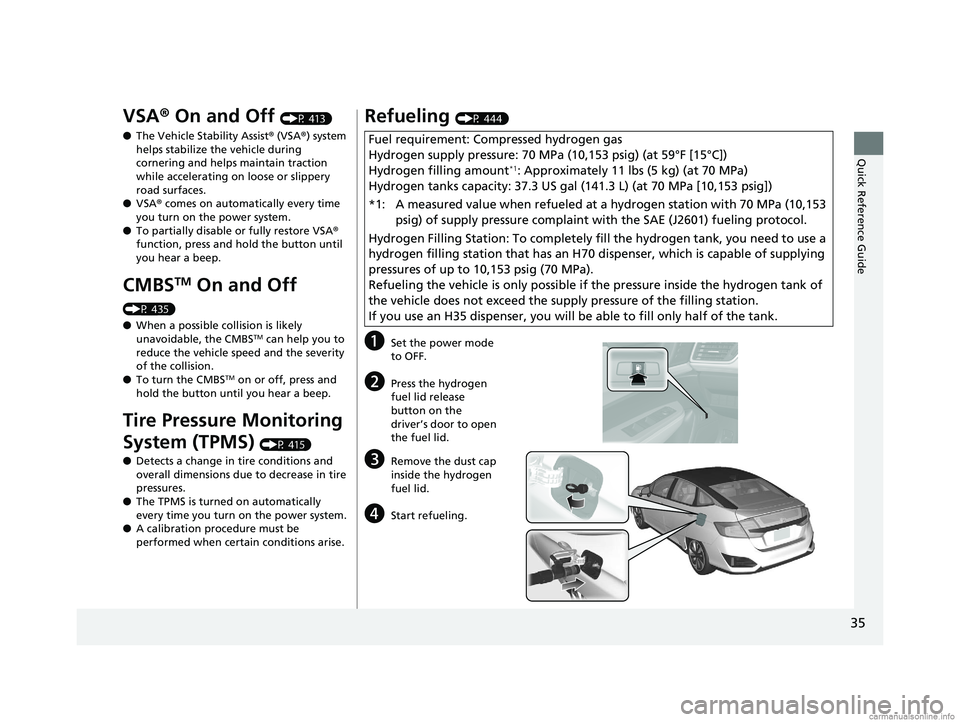Page 16 of 551

14
Quick Reference Guide
Fuel Cell Vehicle Precautions
Hydrogen-related Components
Fuel cell vehicles have hydrogen-related components such as hydrogen tanks, an FC stack,
and hydrogen pipelines.
Labels with handling warnings are attached to these components.
Hydrogen
Leak
Detection
System
FC StackHydrogen
Leak
Detection
System
Hydrogen Fuel
Receptacle Hydrogen Tanks
Hydrogen Pipelines
Hydrogen-retaining components
●Hydrogen tanks●Hydrogen pipelines●FC stack
Components with a warning label
●Hydrogen tanks●Compressed hydrogen pipeline●Hydrogen fill pipeline●FC stack●Hydrogen ventilation duct
Hydrogen Leak Detection System locations
●In the motor
compartment●Above the hydrogen fuel receptacle Hydrogen Ventilation Duct
a
Label
a Hydrogen Ventilation Duct
Fuel cells consume oxygen when generating
electricity. If the vehicle is left in standby
state in an enclosed area, the air may
become deprived of oxygen, resulting in
asphyxiation of any person(s) in the area.
Make sure the area is well ventilated before
turning the power system on. If the vehicle
is in a garage, keep the door open.
WARNING
Never leave the fuel cell vehicle in standby
state in an enclosed area that has limited
ventilation as there is a risk of oxygen
deprivation.
WARNING
Do not attempt to modify, install, or
disassemble the hydrogen-related
components.
The hydrogen-related components are
filled with hydrogen gas. Removing or
disassembling these components may cause
a hydrogen gas leak which can lead to a fire
or explosion.
If you notice anything unusual about your
vehicle, consult an authorized Honda
Clarity Fuel Cell dealer.
18 CLARITY FUEL CELL PPO-31TRT6100.book 14 ページ 2017年11月21日 火曜日 午後3時3分
Page 19 of 551

17
Quick Reference Guide
Hydrogen Leak Detection System
When the power mode is turned to ON, the hydrogen leak detection system is activated. If a
hydrogen gas leak is detected by the hydrogen detector, the hydrogen leak indicator will
come on.
2 Hydrogen Leak Indicator (P90)
Hydrogen Supply/High Voltage Shut-off System
If the FC system is on and the vehicle is involv ed in a crash, depending on the severity of the
impact, the shut-off system will cut off the supply of hydrogen and electricity. In this case, it
is not possible to restart the vehicle.
To restart the FC system, consult an authorized Honda Clarity Fuel Cell dealer.
WARNING
Do not block the hydrogen ventilation
ducts.
The hydrogen tanks, FC stack, and
hydrogen supply components have
ventilation ducts to allow any leaked
hydrogen to escape into the atmosphere. If
the opening of a duct is blocked with snow,
leaves, etc., and a hydrogen leak occurs, the
leaked gas can make its way into the motor
room, where it can ignite, resulting in a fire
or explosion.
Make sure the ducts are free of any
obstructions before activating the power
system.
Do not remove or disassemble a hydrogen
duct: Doing so can lead to a fire or
explosion if a hydrogen gas leak occurs.
Hydrogen
Ventilation Duct
(Above the both
front tires) Hydrogen
Ventilation Duct
(Inside the fuel
lid)
18 CLARITY FUEL CELL PPO-31TRT6100.book 17 ページ 2017年11月21日 火曜日 午後3時3分
Page 37 of 551

35
Quick Reference Guide
VSA® On and Off (P 413)
● The Vehicle Stability Assist ® (VSA® ) system
helps stabilize the vehicle during
cornering and helps maintain traction
while accelerating on loose or slippery
road surfaces.
● VSA ® comes on automatically every time
you turn on the power system.
● To partially disable or fully restore VSA ®
function, press and ho ld the button until
you hear a beep.
CMBSTM On and Off
(P 435)
● When a possible collision is likely
unavoidable, the CMBS
TM can help you to
reduce the vehicle speed and the severity
of the collision.
● To turn the CMBS
TM on or off, press and
hold the button until you hear a beep.
Tire Pressure Monitoring
System (TPMS)
(P 415)
● Detects a change in tire conditions and
overall dimensions due to decrease in tire
pressures.
● The TPMS is turned on automatically
every time you turn on the power system.
● A calibration procedure must be
performed when certain conditions arise.
Refueling (P 444)
aSet the power mode
to OFF.
bPress the hydrogen
fuel lid release
button on the
driver’s door to open
the fuel lid.
cRemove the dust cap
inside the hydrogen
fuel lid.
dStart refueling.
Fuel requirement: Compressed hydrogen gas
Hydrogen supply pressure: 70 MP a (10,153 psig) (at 59°F [15°C])
Hydrogen filling amount
*1: Approximately 11 lbs (5 kg) (at 70 MPa)
Hydrogen tanks capacity: 37.3 US gal (141.3 L) (at 70 MPa [10,153 psig])
*1:
A measured value when refueled at a hydrogen station with 70 MPa (10,153
psig) of supply pressure complaint with the SAE (J2601) fueling protocol.
Hydrogen Filling Station: To completely fi ll the hydrogen tank, you need to use a
hydrogen filling station that has an H70 di spenser, which is capable of supplying
pressures of up to 10,153 psig (70 MPa).
Refueling the vehicle is only possible if the pressure inside the hydrogen tank of
the vehicle does not exc eed the supply pressure of the filling station.
If you use an H35 dispenser, you will be able to fill only half of the tank.
18 CLARITY FUEL CELL PPO-31TRT6100.book 35 ページ 2017年11月21日 火曜日 午後3時3分